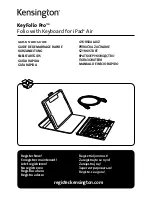
23 / 34
Electric Connection
The FFG-T...EX sensor in areas exposed to danger of explosion are allowed to
be connected to buffer amplifiers only if these are certificated by a generally
accepted test institute, and if the electric specifications thereof are compliance
with the following conditions:
Ui =
≤30 V
Ii =
≤0,2 A
Pi =
≤1 W
KSR Level Sensor FFG-T..EX (Standard and 3A design) Ex ia
KSR Level Sensor FFG-T...EX (Bypass design) Ex ib
The electric specifications on the type plate and the additional provisions for installing intrinsically
safe circuits should be abided by. No work is allowed to be carried out unless by trained experts.
The electric connection of the FFG-T...EX sensor is via built-in clamps. The given connecting
pattern is conveyed by the connecting diagram within the interior of the connecting case, or by the
mounting and operating instructions.
Selection of Connecting Cable
Wiring of the FFG-T...EX system requires a 2-core cable to be connected in the probe
head of the sensor. The cable cross-section must be selected so that the supply
voltage on the FFG-T...EX sensor is no less than 10 V in the borderline case of maximum current
consumption (21.5 mA) in a given cable length L. A copper cable with a cable cross-section of 1
mm
2
and a length of 100 m (100 m forward and 100 m return line) has a resistivity of 3.4 Ω
(R =
0,034 Ω x L (m)/F (mm
2
)). If a supplier provides, for example, 13 V at 21.5 mA, the sum of
resistors contained in the supply line is not allowed to be in excess of (13 V-10V)/0.0215 A = 139
Ω. If the cable is of a cross-section of 0.5mm
2
and if no burden is contained in the line, the feeder
line is not all
owed to have a length greater than L = 139 (Ω) x 0.5 (mm
2
)/0,034 m = 2050 m.
Note the given connecting pattern
The connection should be carried out by the light-blue-marked cable. The diameter of the
connecting cable must be within the clamping range of the cable passage (
5
– 10 mm
). Using
other cable diameters involves the danger of moisture ingress.
The use of individual strands is not permitted!
Cable Capacity and Inductivity
When determining the required cable length, the highest permitted inductivities and
capacities of the connected intrinsically safe valuator should be observed. These values
are not allowed to be exceeded.












































